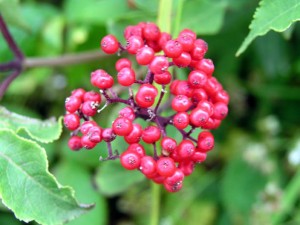
Elderberry
Plants that are allergenic or that cause dermatitis or mechanical injury are annoying, but the victim usually recovers. Plants that are poisonous when eaten, however, may cause serious illness or even death.
Since these plants are harmful only if chewed, sucked, or swallowed, poisoning can nearly always be avoided by keeping all plant parts out of the mouth. Some plants, such as white snakeroot and brackenfern, however, contain poisons that can be transferred into milk if cows eat the plant. People who drink such contaminated milk also may become poisoned. Entire plants may be poisonous, or the toxicity may be confined only to roots, vegetative parts, berries, or seeds. Plants may be highly toxic at certain stages of growth and relatively harmless at others. Poison hemlock, oleander, and the seed of rosary pea and castorbean are so poisonous that small amounts may be fatal if eaten. Marijuana and the seed of jimsonweed and other species of “Datura” produce a narcotic effect. The seeds of jimsonweed have caused such severe hallucinations and disorientation in humans that deaths have resulted from secondary causes such as drowning and exposure.
Most cases of internal poisoning are accidental and occur primarily among children who are attracted to brightly colored berries and seeds, or who suck and chew other plant parts. Children and adults alike should be taught never to put any part of a plant in the mouth, much less swallow it, unless they can positively identify the plant and know it to be safe.
Some important poisonous plants:
- Bitter nightshade
- Blue cohosh
- Brackenfern
- Buckeye, horsechestnut
- Castorbean
- Chokecherry
- Death camas, poison camas
- Destroying angels, death cup, fly agaric
- Elderberry
- European buckthorn
- Jimsonweed, thornapple, datura
- Larkspur
- Mistletoe
- Monkshood, wolfbane
- Moonseed
- Mountain Laurel
- Oleander
- Poison hemlock, hemlock
- Pokeberry, pokeweed, pigeonberry, inkweed, garget, scobe
- Precatory bean, rosary pea, crab’s eye, jequirity bean
- Western baneberry, dolls-eyes, snakeberry
- Western waterhemlock
- White snakeroot, snakeroot
- Oleander
- Yellow jessamine
- Yew
Useful resources on poisonous plants:
- Canadian Poisonous Plants Information System (Government of Canada)
- Common Poisonous Plants and Plant Parts (Texas A&M AgriLife Extension)
- FDA Poisonous Plant Database (U.S. Food and Drug Administration)
- Guide to Toxic Plants in Forages (Purdue University)
- Indiana Plants Poisonous to Livestock and Pets (Purdue University)
- Plants Poisonous to Livestock and Other Animals (Cornell University)
- Poisonous Plants (Center for Disease Control and Prevention)
- Poisonous Plants (The University of Arizona)
- Poisonous Plant Guide (The University of Utah)
- Poisonous Plants Database (University of Pennsylvania)
- Poisonous Plants of North Carolina (North Carolina State University)
- Poisonous Plants of the Southern United States (West Virginia University)






